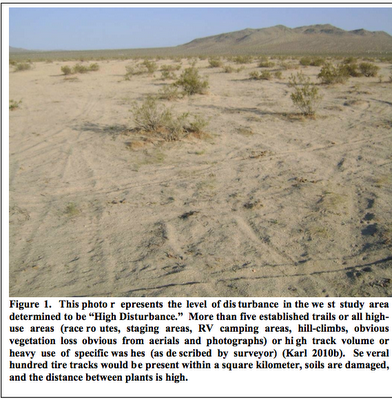BLM to Host Public Meetings on Off-Road Plan
The Bureau of Land Management (BLM) is holding two public meetings to gather information on issues to consider and evaluate as it develops a new off-highway vehicle (OHV, off-road vehicle, ORV) management plan for the western Mojave Desert. You can find more information about the meetings by visiting the BLM announcement, but they will be held on 27 and 29 September.
The BLM last published a west Mojave plan in 2006 designating OHV routes throughout the area, but they added OHV routes that were not in existence in 1980, when the California Desert Conservation Area was approved. The total amounted to 5,098 miles of routes, a number that grows over the years as a result of the illegal creation of new trails by irresponsible users. Veering off a designated route onto fragile desert soils easily creates the beginnings of a brand new route that will be followed by subsequent OHV riders who may not be aware that they are on an illegal trail. The scars etched into the desert cannot sustain insect, plant and wildlife that keep the desert healthy.
A court ordered the BLM to redo its 2006 analysis of the OHV routes, and the public meetings this month are the initial step in developing a revised OHV route management plan.
- Ridgecrest, 6:30-9:30PM, 27 September 2011, Kerr McGee Center, 100 W. California Ave., Ridgecrest, CA 93555 , phone: (760) 499-5151
- Barstow, 6:30-9:30PM, 29 September 2011, Hampton Inn, 2710 Lenwood Road, Barstow, California 92311, phone: (760) 253-2600
The BLM last published a west Mojave plan in 2006 designating OHV routes throughout the area, but they added OHV routes that were not in existence in 1980, when the California Desert Conservation Area was approved. The total amounted to 5,098 miles of routes, a number that grows over the years as a result of the illegal creation of new trails by irresponsible users. Veering off a designated route onto fragile desert soils easily creates the beginnings of a brand new route that will be followed by subsequent OHV riders who may not be aware that they are on an illegal trail. The scars etched into the desert cannot sustain insect, plant and wildlife that keep the desert healthy.
A court ordered the BLM to redo its 2006 analysis of the OHV routes, and the public meetings this month are the initial step in developing a revised OHV route management plan.
 |
| The screenshot above was taken from an Environmental Impact Assessment considering usurping portions of the Johnson Valley OHV area for Twentynine Palms Marine Corps Base. The study showed that some areas of intense OHV uses had badly damaged soils and reduced vegetation, which has ripple effects on other plant life, insects, reptiles and birds. |



Comments
Post a Comment